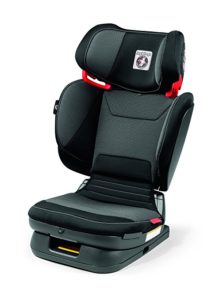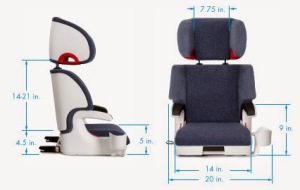
Just as with rear-facing, there’s a lot of debate in the United States over what actually constitute best practices when it comes to when to switch from harnessed front-facing seats to booster seats. However, just as with rear-facing, the Swedes are more than happy to provide guidelines for what to do and when, no matter how much we go back and forth over the basics in the United States.
As a review, rear-facing best practices means doing so for as long as possible, and ideally at least until 4 or 5. This is standard practice in Sweden, where they’ve enjoyed the best child auto safety records on Earth for decades, and it’s now becoming standard practice in neighboring Norway, which has joined Sweden at the top of the mountain in terms of the all-important task of keeping children alive in and around car traffic. While most parents in the United States are still forward-facing shortly after 1, more and more are learning about the benefits of extended rear-facing and are following the Swedish (and now Norwegian) example. So what can they teach us about forward-facing and boostering? We’ll review their practices today.
When do parents forward-face children in Sweden?

This is actually a trick question, because parents in Sweden don’t typically forward-face. Yes, there are some parents who do (just as there are some parents who forward-face their kids before 4 in Sweden), but the vast majority of parents there don’t use forward-facing seats. If they rear-face with convertible seats, which almost all parents do, they simply stop using the seats when their kids outgrow them and switch to…booster seats.
Booster seats?
Yes! In Sweden, the standard practice is to start boostering kids once they outgrow rear-facing seats. This is visible here directly from the NTF, Sweden’s equivalent of the NHTSA:
“Question: At what weight/height/age, the child can be placed on the booster seat instead of in a car seat?
Answer: Children should travel rearward facing car seat (seat for the infant) as long as possible, to the age of 4-5 years. When the child has grown out of its rearward-facing child safety seat (seat for the infant seat) recommend NTF to move on to a booster seat.”
There is no mention whatsoever of a forward-facing harnessed seat; the standard recommendation is to move directly from a rear-facing seat to a booster seat after spending the first 4-5 years (or as long as possible) in a rear-facing seat.
Why do Swedish parents switch to high-back booster seats instead of harnessed or forward-facing seats?

This is done for a few different reasons. One involves the Swedish belief that older children who are harnessed absorb the tremendous collision forces in the head, neck, and shoulders, which is something to be avoided. In fact, this is the reason why rear-facing is so much safer–when rear-facing, the much stronger muscles and much larger surface area of the back are available to absorb forces instead of having them concentrated in the head, neck, and shoulders. The Swedish belief is that when boostered (which is essentially using a seat belt that’s adjusted to fit children as well as adults), the entire torso can move forward in a collision, spreading crash forces throughout the upper body instead of concentrating them in two of the most fragile areas of the body (the head and neck).
Does this mean that “extended harnessing” is not considered best practices in Sweden?
This is correct; in Sweden, virtually no parents practice harnessing, extended or otherwise, because it’s not believed to be safe. What’s done is to move directly from rear-facing in the first 4-5 years to using a high-back booster.
It’s also worth noting that a number of studies in the US have also shown that high-backed boosters are as safe as forward-facing (harnessed) seats once children are mature enough to sit safely in both. In other words, if you raise your child to sit upright and still in a high-back booster seat (and not reach out of it, play with the seat belt, unbuckle himself/herself, or do anything else unsafe), s/he’ll be equally safe in both kinds of seats. In Sweden, the expectation is for kids to do this from 4 or 5 onward, and kids are taught to do so the same way they’re taught not to play in the street or touch stove tops.
If forward-facing isn’t safer than boostering, then why is it recommended in the US?
Forward-facing, or harnessing, is recommended in the US due to a mixture of a lack of knowledge of best practices and due to efforts to mitigate the additional risks of premature boostering.
First of all, most parents in the US aren’t rear-facing until 4 to 5 as in Sweden. Three out of four kids are forward-facing before they turn 2, and only around 1 out of every 100 children will still be rear-facing at 4, which means that forward-facing is the only stage between most 1 year olds in the US and being placed in a booster seat. We know booster seats are absolutely inappropriate for toddlers, so recommending forward-facing at least keeps children in a better position than they’d otherwise face in most homes.
Second, as noted above, most parents aren’t aware of how much safer it is to rear-face instead of forward-face, and this is largely because extended rear-facing isn’t propagated by any large-scale authority in the United States. The NHTSA simply says to rear-face “as long as possible” but fills their diagrams and pamphlets online with references to children forward facing from 1 or 2. The AAP is hopelessly out of date with their recommendations and only switched to recommending rear-facing until 2 a few years ago. The vast majority of states don’t require rear-facing past 1. To put it simply, the US is backwards when it comes to car safety, and the main Americans you’ll see advocating extended rear-facing (for example, yours truly) are those who have taken the time to learn about best practices in car seat safety, which are nearly-exclusively found in Sweden.
This adds up to a vicious circle. Parents stop rear-facing after 1 because they don’t know any better, and they don’t know any better because all of the authorities are telling them that they only actually need to rear-face until 1. Meanwhile, they’re told to forward-face with the focus on keeping very young children out of booster seats, which leads to very little emphasis on rear-facing and a lack of understanding of the fact that harnessed seating doesn’t necessarily offer any advantages over boostering once children are mature enough to sit in booster seats. This maturity point, additionally, will vary tremendously with how children have been raised, as well as with individual differences between children.
So what’s best if I want to follow best practices for my child?
Here’s a guide to the first 13 years:
From birth to 5, rear-face. If your child still fits at 5, keep rear-facing. There are several seats that will let you rear-face until 6 or 7, including the the Clek Fllo, the Clek Foonf, the Diono Rainier, the Graco Extend2Fit, the Graco Extend2Fit 3-in-1, the Graco 4Ever Extend2Fit, the Nuna Rava, the Safety 1st Advance EX 65 Air+, and the Safety 1st Grow and Go EX Air.
From 5 (or later, if you can still rear-face) to 10, 11, or 12, use a high-back, then low-back booster. Keep boostering until your child passes the 5-step test. Two of my favorite high-back boosters include the Clek Oobr and Maxi-Cosi RodiFix. Low-back boosters are fine once kids are about 7; high-back boosters are designed to keep kids’ heads in place even if they fall asleep.
Keep your child in the back seat at least until s/he turns 13. Later is always better here. For tips beyond the first 13 years, see the best practices page for teens and drivers of all ages.
—
If you find the information on car safety, recommended car seats, and car seat reviews on this car seat blog helpful, you can shop through this Amazon link for any purchases, car seat-related or not. Canadians can shop through this link for Canadian purchases.

